The Intel Xeon W-3175X Review: 28 Unlocked Cores, $2999
by Ian Cutress on January 30, 2019 9:00 AM ESTCPU Performance: Rendering Tests
Rendering is often a key target for processor workloads, lending itself to a professional environment. It comes in different formats as well, from 3D rendering through rasterization, such as games, or by ray tracing, and invokes the ability of the software to manage meshes, textures, collisions, aliasing, physics (in animations), and discarding unnecessary work. Most renderers offer CPU code paths, while a few use GPUs and select environments use FPGAs or dedicated ASICs. For big studios however, CPUs are still the hardware of choice.
All of our benchmark results can also be found in our benchmark engine, Bench.
For our graphs, some of them have two values: a regular value in orange, and one in red called 'Intel Spec'. ASUS offers the option to 'open up' the power and current limits of the chip, so the CPU is still running at the same frequency but is not throttled. Despite Intel saying that they recommend 'Intel Spec', the system they sent to us to test was actually set up with the power limits opened up, and the results they provided for us to compare to internally also correlated with that setting. As a result, we're providing both sets results for our CPU tests.
Corona 1.3: Performance Render
An advanced performance based renderer for software such as 3ds Max and Cinema 4D, the Corona benchmark renders a generated scene as a standard under its 1.3 software version. Normally the GUI implementation of the benchmark shows the scene being built, and allows the user to upload the result as a ‘time to complete’.
We got in contact with the developer who gave us a command line version of the benchmark that does a direct output of results. Rather than reporting time, we report the average number of rays per second across six runs, as the performance scaling of a result per unit time is typically visually easier to understand.
The Corona benchmark website can be found at https://corona-renderer.com/benchmark
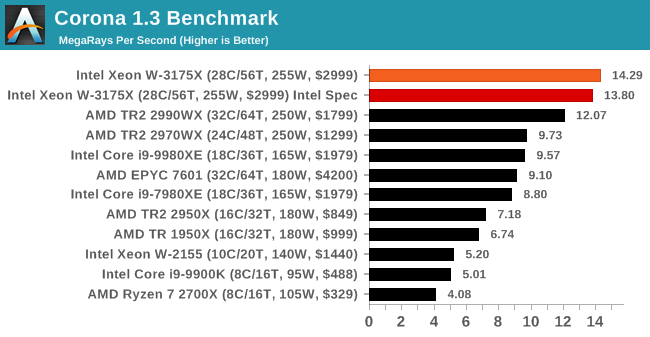
.
Blender 2.79b: 3D Creation Suite
A high profile rendering tool, Blender is open-source allowing for massive amounts of configurability, and is used by a number of high-profile animation studios worldwide. The organization recently released a Blender benchmark package, a couple of weeks after we had narrowed our Blender test for our new suite, however their test can take over an hour. For our results, we run one of the sub-tests in that suite through the command line - a standard ‘bmw27’ scene in CPU only mode, and measure the time to complete the render.
Blender can be downloaded at https://www.blender.org/download/
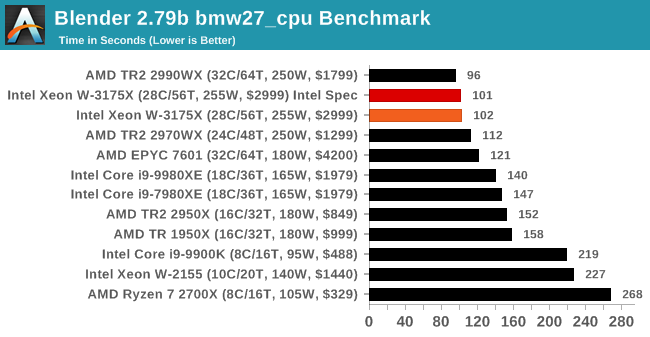
.
LuxMark v3.1: LuxRender via Different Code Paths
As stated at the top, there are many different ways to process rendering data: CPU, GPU, Accelerator, and others. On top of that, there are many frameworks and APIs in which to program, depending on how the software will be used. LuxMark, a benchmark developed using the LuxRender engine, offers several different scenes and APIs.
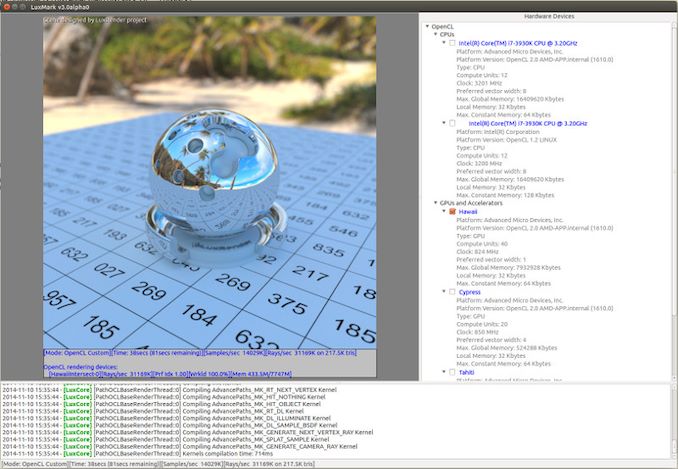
Taken from the Linux Version of LuxMark
In our test, we run the simple ‘Ball’ scene on both the C++ and OpenCL code paths, but in CPU mode. This scene starts with a rough render and slowly improves the quality over two minutes, giving a final result in what is essentially an average ‘kilorays per second’.
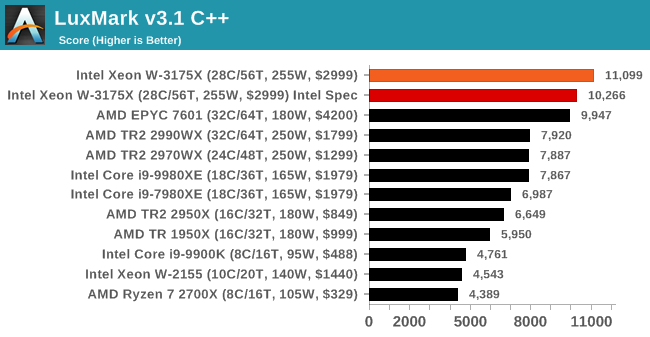
.
POV-Ray 3.7.1: Ray Tracing
The Persistence of Vision ray tracing engine is another well-known benchmarking tool, which was in a state of relative hibernation until AMD released its Zen processors, to which suddenly both Intel and AMD were submitting code to the main branch of the open source project. For our test, we use the built-in benchmark for all-cores, called from the command line.
POV-Ray can be downloaded from http://www.povray.org/
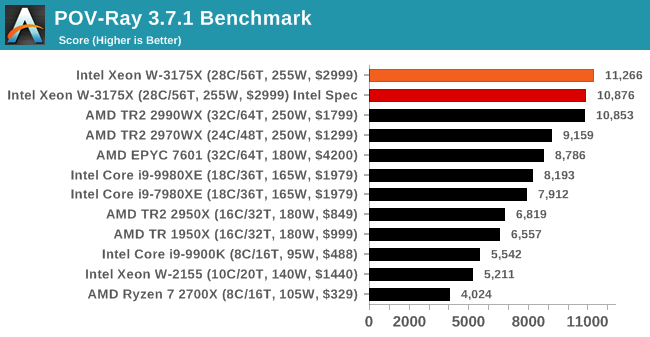
.











136 Comments
View All Comments
eastcoast_pete - Wednesday, January 30, 2019 - link
@Ian: Thanks for the review. I guess the "lower" price of this 28-core Xeon shows the benefit of having strong competition in the market - without the large Threadrippers, that price wouldn't have come down from the $ 8,000 mark.Two questions: I am still struck by how often the higher-end "consumer" grade CPUs beat the pants off the many-core monsters. Is high single-thread performance still that dominant in the applications in which the 9900K or 2700x lead the pack?
Second, did Intel really recommend to plug this monster directly into a wall outlet? If yes, wow. Guess you need a surge-protected, line-conditioned house line then, so not exactly standard equipment. Having encountered brownouts and voltage spikes, I wouldn't plug even a $ 500 PC straight into an unprotected household socket, never mind a $ 7,000 rig. I guess if that's what they recommend, it doesn't void the warranty when stuff happens.
My other comment is that this chip is really about workstation-type tasks, and while I know that coming up with more workstation-specific test suites is too specialized, that's where these Xeons and the big Threadrippers start making sense.
Regarding gaming: As you also hint at, much of that $ 3,000 budget for the CPU would be better spend on two or more high-end graphics cards (2080 GTX), all liquid cooling, a hand-selected eight core CPU, and a large, ultra-wide aspect fast refresh HDR-capable monitor.
zepi - Wednesday, January 30, 2019 - link
Ian is working in UK. He has most likely something like 230V single phase 80A feed-in to his house, if not 100 or even 120A, depending if he has electric heating or gas.One main fuse for that surely. Then that phase is split to some smaller circuits feeding into separate rooms & sockets etc. probably 8-16A fuses. Some stronger ones (30+A) if he has electric heaters in the taps / shower without using a boiler & heating circuits.
Then another fuse in each wall socket. And most likely a fourth fuse inside the actual cable.
And @230V, the cable "only" needs to support 7A, so it is actually nothing spectacular.
1500W devices are perfectly fine in Europe, mostly because of the 230V voltage. It just makes things much easier.
SaturnusDK - Wednesday, January 30, 2019 - link
Many if not most European households have 3 phase 230V 16A power, so you can power standard 400V appliances.BushLin - Wednesday, January 30, 2019 - link
In the UK a standard wall outlet is rated for 13A. Our kettles are nearly all 3KW. We value our tea and have built our homes around it.eastcoast_pete - Wednesday, January 30, 2019 - link
But then, your kettle doesn't require clean sine wave AC current, and won't suffer much if the voltage drops or spikes. In contrast, an expensive rig like this might. My comment wasn't about overall power need of this setup, but my surprise over the "unfiltered wall socket is fine" instruction from Intel.eastcoast_pete - Wednesday, January 30, 2019 - link
I am quite familiar with the situation in Europe. But, even there, I wouldn't just trust a regular power outlet (220 or 230 V) to provide clean sine power free from interference, voltage drops (brownouts) and voltage spikes, and neither do several friends of mine who live and work in Europe. They also use, at minimum, a good surge protector, and, for expensive systems, a UPS and line conditioner, just like we do here in the States.SaturnusDK - Thursday, January 31, 2019 - link
Surge protection is built into all regulatory fuse boxes so you don't need that in Europe since 2003 unless the building hasn't been updated to the current building code. Also before 2003 it was 220V in Europe and 240V in the UK. Now it's just 230V everywhere. Last there was a registered brown out in the area I live and work was February 1987... almost 32 years ago. In many areas of Europe it's not even worth considering as a risk anymore. You still need an UPS for obvious reasons though.maroon1 - Wednesday, January 30, 2019 - link
At least it is faster and has more consistence performance than 2990WX. Gaming performance also much better without the need to disable cores like you do for 2990WXtamalero - Wednesday, January 30, 2019 - link
I'm still scratching my head on who would buy this thing for "gaming" o_Oalacard - Wednesday, January 30, 2019 - link
Damn Ian you're on a roll with this on the heels of your incredible Intel's 10nm Cannon Lake and Core i3-8121U Deep Dive Review. Do you ever sleep?There's so much talent here that all you guys really should quit working for Purch and start your own independent tech site where the ads are reasonable and not exploitative. I can imagine everyone running straight to it and supporting it. Make it run on small ads and donations and you'd probably make out like kings.
Purch doesn't deserve you, period. Takes your talents elsewhere.